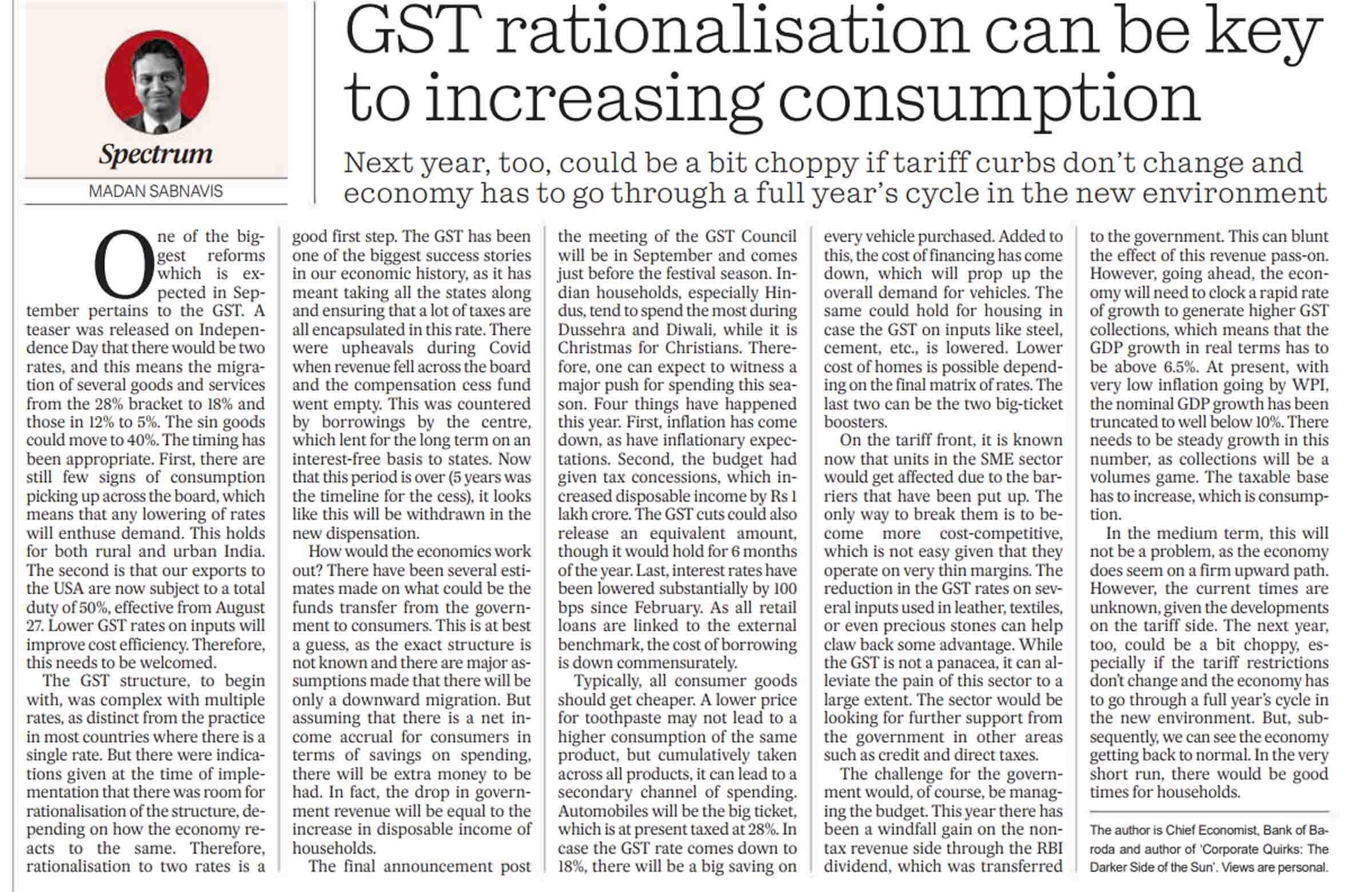GST rationalisation can be key to increasing consumption
GST rationalisation can be key to increasing consumption
Next year, too, could be a bit choppy if tariff curbs don't change and economy has to go through a full year's cycle in the new environment
Spectrum
madan sahabvi
ne of the big-gest reforms which is ex-pected in Sep-tember pertains to the GST. A teaser was released on Indepen-dence Day that there would be two rates, and this means the migra-tion of several goods and services from the 28% bracket to 18% and those in 12% to 5%. The sin goods could move to 40%. The timing has been appropriate. First, there are still few signs of consumption picking up across the board, which means that any lowering of rates will enthuse demand. This holds for both rural and urban India.
The second is that our exports to the USA are now subject to a total duty of 50%, effective from August 27. Lower GST rates on inputs will improve cost efficiency. Therefore, this needs to be welcomed.
The GST structure, to begin with, was complex with multiple rates, as distinct from the practice in most countries where there is a single rate. But there were indica-tions given at the time of imple-mentation that there was room for rationalisation of the structure, de-pending on how the economy re-acts to the same. Therefore, rationalisation to two rates is a
good first step. The GST has been one of the biggest success stories in our economic history, as it has meant taking all the states along and ensuring that a lot of taxes are all encapsulated in this rate. There were upheavals during Covid when revenue fell across the board and the compensation cess fund went empty. This was countered by borrowings by the centre, which lent for the long term on an interest-free basis to states. Now that this period is over (5 years was the timeline for the cess), it looks like this will be withdrawn in the new dispensation.
How would the economics work out? There have been several esti-mates made on what could be the funds transfer from the govern-ment to consumers. This is at best a guess, as the exact structure is not known and there are major as-sumptions made that there will be only a downward migration. But assuming that there is a net in-come accrual for consumers in terms of savings on spending, there will be extra money to be had. In fact, the drop in govern-ment revenue will be equal to the increase in disposable income of households.
The final announcement post
the meeting of the GST Council will be in September and comes just before the festival season. In-dian households, especially Hin-dus, tend to spend the most during Dussehra and Diwali, while it is Christmas for Christians. There-fore, one can expect to witness a major push for spending this sea-son. Four things have happened this year. First, inflation has come down, as have inflationary exрес-tations. Second, the budget had given tax concessions, which in-creased disposable income by Rs 1 lakh crore. The GST cuts could also release an equivalent amount, though it would hold for 6 months of the year. Last, interest rates have been lowered substantially by 100 bps since February. As all retail loans are linked to the external benchmark, the cost of borrowing is down commensurately.
Typically, all consumer goods should get cheaper. A lower price for toothpaste may not lead to a higher consumption of the same product, but cumulatively taken across all products, it can lead to a secondary channel of spending. Automobiles will be the big ticket, which is at present taxed at 28%. In case the GST rate comes down to 18%, there will be a big saving on
every vehicle purchased. Added to this, the cost of financing has come down, which will prop up the overall demand for vehicles. The same could hold for housing in case the GST on inputs like steel, cement, etc., is lowered. Lower cost of homes is possible depend-ing on the final matrix of rates. The last two can be the two big-ticket boosters.
On the tariff front, it is known now that units in the SME sector would get affected due to the bar-riers that have been put up. The only way to break them is to be-come more cost-competitive, which is not easy given that they operate on very thin margins. The reduction in the GST rates on sev-eral inputs used in leather, textiles, or even precious stones can help claw back some advantage. While the GST is not a panacea, it can al-leviate the pain of this sector to a large extent. The sector would be looking for further support from the government in other areas such as credit and direct taxes.
The challenge for the govern-ment would, of course, be manag-ing the budget. This year there has been a windfall gain on the non-tax revenue side through the RBI dividend, which was transferred
to the government. This can blunt the effect of this revenue pass-on. However, going ahead, the econ-omy will need to clock a rapid rate of growth to generate higher GST collections, which means that the GDP growth in real terms has to be above 6.5%. At present, with very low inflation going by WPI, the nominal GDP growth has been truncated to well below 10%. There needs to be steady growth in this number, as collections will be a volumes game. The taxable base has to increase, which is consump-tion.
In the medium term, this will not be a problem, as the economy does seem on a firm upward path. However, the current times are unknown, given the developments on the tariff side. The next year, too, could be a bit choppy, es-pecially if the tariff restrictions don't change and the economy has to go through a full year's cycle in the new environment. But, sub-sequently, we can see the economy getting back to normal. In the very short run, there would be good times for households.
The author is Chief Economist, Bank of Ba-roda and author of 'Corporate Quirks: The Darker Side of the Sun'. Views are personal.

